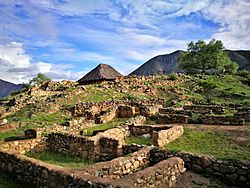Kotosh facts for kids

Partial view of the site.
|
|
| Lua error in Module:Location_map at line 420: attempt to index field 'wikibase' (a nil value). | |
| Location | Huánuco |
|---|---|
| Type | Settlement |
| History | |
| Cultures | Kotosh Religious Tradition, Chavín culture |
Kotosh is an archaeological site in Peru, close to the city of Huánuco. It's a very old place with many layers of history. Imagine it like a giant historical sandwich! Archaeologists have found six different periods where people lived there, one on top of the other.
Contents
Discovering Ancient Kotosh
This amazing site shows us how people lived in ancient Peru for thousands of years. Each layer tells a story about the cultures that called Kotosh home. It's a key place for understanding the early history of the Andes region.
Layers of Time: What We Found
When archaeologists dig at a site like Kotosh, they find different layers of soil and artifacts. This is called stratigraphy. Each layer represents a different time period. At Kotosh, experts found three main cultural periods that existed even before the famous Chavín culture. These periods are:
- Kotosh Period
- Wairajirca Period
- Mito Period
The Kotosh Period
The Kotosh Period layer was found right under the Chavín culture layer. This means it was the most recent of the three older periods. During this time, people started growing maize (corn). This was a big step for ancient farming!
Some things from the Kotosh Period look similar to items from the later Chavín culture. For example, they found special pottery with stirrup spouts (a type of handle). They also found pottery with simple patterns made by pressing stamps onto the clay. Some designs were curvy, and black paint was used on red pottery. There's also a type of pottery called Kotosh Black Polished Incised, which looks a lot like pottery from the Classical Chavín period. This suggests a connection between these ancient groups.
The Wairajirca Period
This period is important because it's when the first pottery appeared at Kotosh. The pottery from this time is called Wayrajirca pottery. It was first found at a place called Wayrajirca, but it's also been found in other parts of the northern highlands.
Wayrajirca pottery often has a polished brown or black look. It's decorated with cuts (incisions) and paint added after the pottery was fired. The designs are usually simple and geometric, like lines and shapes. Later on, some designs started to include human-like figures. The Kotosh Period, which came after, kept many of these pottery traditions alive.
The Mito Period
The Mito Period is the oldest cultural period found at Kotosh. It's known as a "preceramic" period, meaning people didn't make pottery yet. This was a very early time in human history in Peru.
During the Mito Period, a very special building was first constructed: The Temple of the Crossed Hands. This temple is famous for its unique sculptures of crossed arms. These crossed arms became a special symbol for the Kotosh temples. Archaeologists also found some stone tools from the Lauricocha culture in this period's layers. This shows connections between different ancient groups.
See also
 In Spanish: Kotosh para niños
In Spanish: Kotosh para niños

